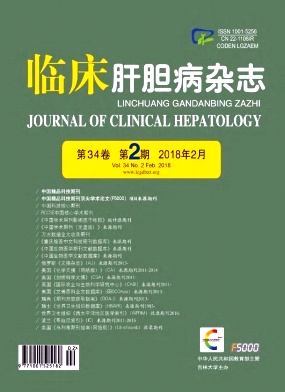|
[1]TORRE LA, BRAY F, SIEGEL RL, et al.Global cancer statistics, 2012[J].CA Cancer J Clin, 2015, 65 (2) :87-108.
|
|
[2]CHU KK, CHEUNG TT.Update in management of hepatocellular carcinoma in Eastern population[J].World J Hepatol, 2015, 7 (11) :1562-1571.
|
|
[3]BRUIX J, SHERMAN M.Management of hepatocellular carcinoma:an update[J].Hepatology, 2011, 53 (3) :1020-1022.
|
|
[4]EL-SERAG HB.Hepatocellular carcinoma[J].N Engl J Med, 2011, 365 (12) :1118-1127.
|
|
[5]LIN F.Research advances in clinical diagnosis, prognostic evaluation, and treatment of liver failure[J].J Clin Hepatol, 2016, 32 (9) :1678-1683. (in Chinese) 林锋.肝衰竭的临床诊断、预后评估和治疗进展[J].临床肝胆病杂志, 2016, 32 (9) :1678-1683.
|
|
[6]Mc CORMACK L, PETROWSKY H, JOCHUM W, et al.Hepatic steatosis is a risk factor for postoperative complications after major hepatectomy:a matched case-control study[J].Ann Surg, 2007, 245 (6) :923-930.
|
|
[7]DURAND F, VALLA D.Assessment of the prognosis of cirrhosis:Child-Pugh versus MELD[J].J Hepatol, 2005, 42 (Suppl 1) :s100-s107.
|
|
[8]JOHNSON PJ, BERHANE S, KAGEBAYASHI C, et al.Assessment of liver function in patients with hepatocellular carcinoma:a new evidence-based approach-the ALBI grade[J].J Clin Oncol, 2015, 33 (6) :550-558.
|
|
[9]WANG YY, ZHONG JH, SU ZY, et al.Albumin-bilirubin versus Child-Pugh score as a predictor of outcome after liver resection for hepatocellular carcinoma[J].Br J Surg, 2016, 103 (6) :725-734.
|
|
[10]WAI CT, GREENSON JK, FONTANA RJ, et al.A simple noninvasive index can predict both significant fibrosis and cirrhosis in patients with chronic hepatitis C[J].Hepatology, 2003, 38 (2) :518-526.
|
|
[11]CASTERA L, VERGNIOL J, FOUCHER J, et al.Prospective comparison of transient elastography, Fibrotest, APRI, and liver biopsy for the assessment of fibrosis in chronic hepatitis C[J].Gastroenterology, 2005, 128 (2) :343-350.
|
|
[12]ICHIKAWA T, UENISHI T, TAKEMURA S, et al.A simple, noninvasively determined index predicting hepatic failure following liver resection for hepatocellular carcinoma[J].J Hepatobiliary Pancreat Surg, 2009, 16 (1) :42-48.
|
|
[13]BERZIGOTTI A, REIG M, ABRALDES JG, et al.Portal hypertension and the outcome of surgery for hepatocellular carcinoma in compensated cirrhosis:a systematic review and meta-analysis[J].Hepatology, 2015, 61 (2) :526-536.
|
|
[14]RAHBARI NN, GARDEN OJ, PADBURY R, et al.Posthepatectomy liver failure:a definition and grading by the International Study Group of Liver Surgery (ISGLS) [J].Surgery, 2011, 149 (5) :713-724.
|
|
[15]DINDO D, DEMARTINES N, CLAVIEN PA.Classification of surgical complications:a new proposal with evaluation in a cohort of6336 patients and results of a survey[J].Ann Surg, 2004, 240 (2) :205-213.
|
|
[16]PUTTER H, FIOCCO M, GESKUS RB.Tutorial in biostatistics:competing risks and multi-state models[J].Stat Med, 2007, 26 (11) :2389-2430.
|
|
[17]LI FW, LEI ZQ, ZHANG QQ, et al.Establishment of nomogram model for predicting posthepatectomy liver failure in patients with HBV-related hepatocellular carcinoma[J/CD].Chin J Hepatic Surg:Electronic Edition, 2017, 6 (5) :358-362. (in Chinese) 李风伟, 雷正清, 张茜茜, 等.预测HBV相关肝细胞癌肝切除术后肝衰竭列线图模型的建立[J/CD].中华肝脏外科手术学电子杂志, 2017, 6 (5) :358-362.
|
|
[18]WIESNER R, EDWARDS E, FREEMAN R, et al.Model for end-stage liver disease (MELD) and allocation of donor livers[J].Gastroenterology, 2003, 124 (1) :91-96.
|
|
[19]CHEN RC, CAI YJ, WU JM, et al.Usefulness of albumin-bilirubin grade for evaluation of long-term prognosis for hepatitis B-related cirrhosis[J].J Viral Hepat, 2017, 24 (3) :238-245.
|
|
[20]KUO YH, WANG JH, HUNG CH, et al.The ALBI grade predicts the prognosis of patients with advanced hepatocellular carcinoma received sorafenib[J].J Gastroenterol Hepatol, 2017.[Epub ahead of print]
|
|
[21]HIRAOKA A, KUMADA T, MICHITAKA K, et al.Usefulness of albumin-bilirubin grade for evaluation of prognosis of 2584 Japanese patients with hepatocellular carcinoma[J].J Gastroenterol Hepatol, 2016, 31 (5) :1031-1036.
|
|
[22]DIENSTAG JL.The role of liver biopsy in chronic hepatitis C[J].Hepatology, 2002, 36 (5 Suppl 1) :s152-s160.
|
|
[23]LOAEZA-DEL-CASTILLO A, PAZ-PINEDA F, OVIEDOCARDENAS E, et al.AST to platelet ratio index (APRI) for the noninvasive evaluation of liver fibrosis[J].Ann Hepatol, 2008, 7 (4) :350-357.
|
|
[24]SOOKOIAN S, CASTANO GO, SCIAN R, et al.Serum aminotransferases in nonalcoholic fatty liver disease are a signature of liver metabolic perturbations at the amino acid and Krebs cycle level[J].Am J Clin Nutr, 2016, 103 (2) :422-434.
|
|
[25]OKUDA M, LI K, BEARD MR, et al.Mitochondrial injury, oxidative stress, and antioxidant gene expression are induced by hepatitis C virus core protein[J].Gastroenterology, 2002, 122 (2) :366-375.
|
|
[26]SHEN SL, FU SJ, CHEN B, et al.Preoperative aspartate aminotransferase to platelet ratio is an independent prognostic factor for hepatitis B-induced hepatocellular carcinoma after hepatic resection[J].Ann Surg Oncol, 2014, 21 (12) :3802-3809.
|
|
[27]CHENG J, ZHAO P, LIU J, et al.Preoperative aspartate aminotransferase-to-platelet ratio index (APRI) is a predictor on postoperative outcomes of hepatocellular carcinoma[J].Medicine (Baltimore) , 2016, 95 (48) :e5486.
|














 DownLoad:
DownLoad: